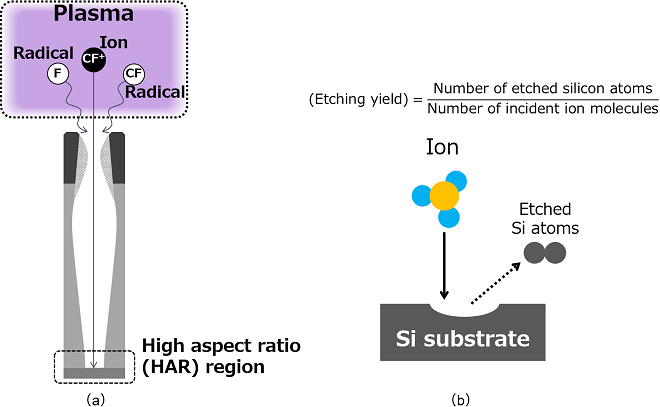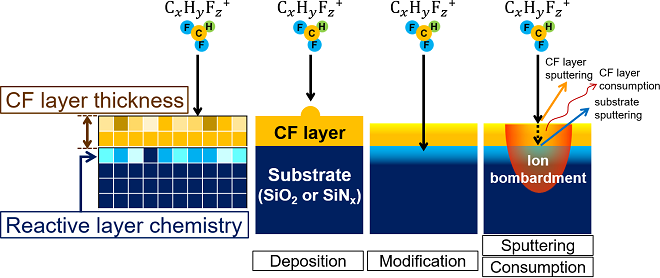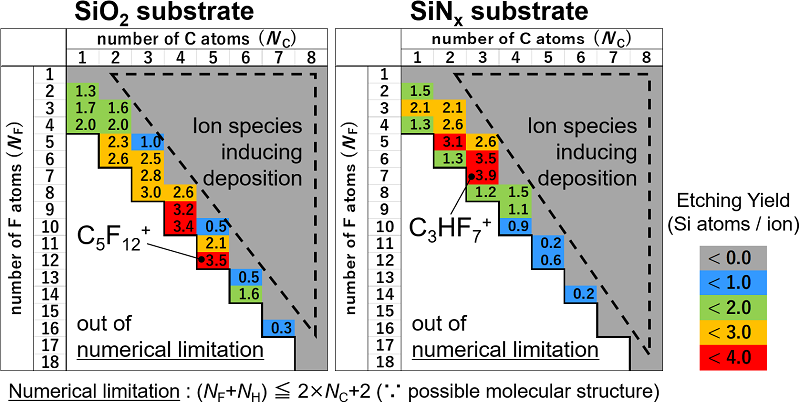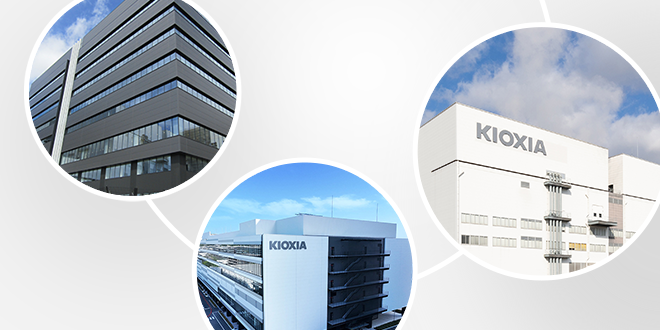Please select your location and preferred language where available.
Phenomenological model for predicting CxHyFz+ ion etching yields
January 12, 2023
As the demand for larger memory capacities has rapidly increased, the aspect ratio of the most critical structure in 3D memory devices has exceeded 100 and continues to increase. The plasma etching process for the high aspect ratio structure makes a crucial impact on productivity*1,2. Ion species play a dominant role in the high aspect ratio etching because of its high directivity, even though both radical and ion species are generated in the plasma reactor (Fig.1(a)). In this report, we introduce a simulation technique to predict optimal ion species for the high aspect ratio etching.

An etching ability of an ion species is defined as its etching yield (Fig.1(b)). Some ion etching yields have been measured by mass-selected ion beam experiments[1] and calculated by molecular dynamics simulations[2]. However, they require considerable time and effort. In addition to that, we have insufficient information about the etching yields of larger ion species. To address this challenge, we developed a simulation model of ion-induced surface reactions and predicted the ion etching yield of larger ion species.
Figure 2 shows ion-induced surface reactions. These reactions occur simultaneously. The etching of the substrate material progresses while retaining the CF layer composed of carbon and fluorine atoms on the top of the substrate. The proposed model elucidates this complex phenomenon using the Monte Carlo method. The ion etching yield can be calculated from an ion dose, a density of the substrate, and an etch rate at a steady state. The proposed model made it possible to calculate the ion etching yield in a short turn-around-time. Specifically, it takes several tens of seconds for each case.

The proposed model enables a comprehensive investigation for the optimal ion species because of short turn-around-time. Figure 3 shows maps of the etching yields of SiO2 substrate and SiNx substrate. These results provide quantitative understandings of the etching yields, such as dependency on the ion composition and the substrate material.

Applications of the simulation technology diverge to various use, not only process improvement proposals, but also intuitive understanding of phenomena and sharing of a common view among process engineers. We continue to contribute to good prospects of process development through the complementary use of an experimental approach and simulation technology.
- “RIE Technology Supporting BiCS FLASH™” in this website
- “Profile control of memory hole etching based on mechanism elucidation” in this website
This achievement was presented in the 43rd International Symposium on Dry Process (DPS2022), in November 2022[3].
Company names, product names, and service names may be trademarks of third-party companies.
Reference
[1] K. Karahashi, K. Yanai, K. Ishikawa, H. Tsuboi, K. Kurihara, and M. Nakamura, J. Vac. Sci. Technol. A 22, 1166 (2004).
[2] K. Miyake, T. Ito, M. Isobe, K. Karahashi, M. Fukasawa, K. Nagahata, T. Tatsumi, and S. Hamaguchi, Jpn. J. Appl. Phys. 53, 03DD02 (2014).
[3] A. Kawamoto, J. Kataoka, S. Kuboi, T. Sasaki, and N. Tamaoki, Proceedings of 43th Dry Process Symposium (Osaka, 2022), p.14.

